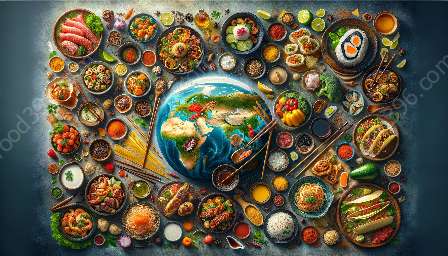When we think of food, we often focus on its taste and nutritional value. However, it's essential to understand the intricate relationship between food and economics. This comparative study of world cuisines delves into the influence of economic factors on global food culture, production, trade, and consumption. From the macroeconomic impact of agricultural policies to the microeconomic behavior of consumers, the dynamics of food and economics significantly shape the culinary landscape.
1. Breadbasket to Fork: Agricultural Economics
Agricultural economics lies at the heart of food production and its subsequent impact on societies. The concept of 'breadbasket to fork' encapsulates the entire process, from cultivating essential crops in agricultural regions to the final consumption by consumers. Economists study the allocation of scarce resources in agricultural production, such as land, labor, and capital, and their impact on food supply, prices, and food security. Factors like crop yield, climate change, technological advancements, and government policies significantly influence the economic viability of food production, ultimately shaping the availability and affordability of various cuisines.
2. Global Gastronomy: Trade and Comparative Advantage
Global trade plays a pivotal role in shaping the diversity of world cuisines. Through the lens of comparative advantage, countries specialize in producing goods and services for which they have a lower opportunity cost. This principle applies to food as well, with countries leveraging their unique resources, climate, and expertise to cultivate specific crops and produce distinct culinary ingredients. The economic theory of comparative advantage fosters international food trade, allowing consumers to savor a wide array of delicacies from around the globe. However, trade agreements, tariffs, and geopolitical tensions can influence the accessibility and affordability of certain cuisines, thereby impacting cultural exchange and gastronomic diversity.
3. Consumer Behavior: Food and Beverage Choices
At an individual level, economic considerations heavily influence food and beverage choices. Consumers make decisions based on factors such as income, price, taste preferences, cultural influences, and health concerns. The concept of price elasticity of demand becomes particularly relevant, as consumers may adjust their consumption patterns in response to changes in food prices. Moreover, the rise of ethical consumerism and sustainable food practices has prompted shifts in consumer preferences, thereby influencing the economics of food production and supply chains. These evolving patterns of consumer behavior have profound implications for both the food industry and the broader economy.
The Economic Influence on World Cuisines
From the streets of Bangkok to the bistros of Paris, the economic forces at play have a tangible impact on the cuisines enjoyed around the world. Understanding the economic intricacies of food helps anchor the cultural significance of various dishes and culinary traditions. As we explore the intersection of food and economics, it becomes evident that the dining table is not only a site for gustatory pleasure but also a nexus of economic activity that shapes societies and influences global trade relationships.
Through a comparative study of world cuisines, we can appreciate the economic underpinnings that contribute to the richness and diversity of culinary experiences. By analyzing the economic drivers behind food production, distribution, and consumption, we gain a deeper understanding of how food and drink serve as a lens through which to perceive global economic dynamics.

